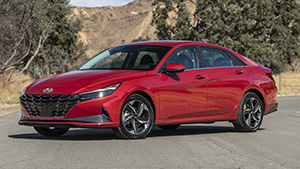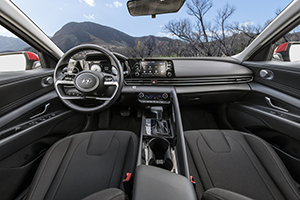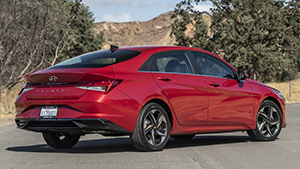2021 Hyundai Elantra
Delivers Exactly what Compact Cars are Supposed to Deliver
Compact cars have come a long way. No longer just entry-level choices for first time new car buyers, today’s compacts include just about every comfort and convenience feature found on larger family sedans and even luxury cars. Now Hyundai’s Elantra has played a big part in that transformation; so let’s see what new for their compact for 2021.
This year sees the launch of the 7th generation Elantra, a car that has been a staple in the Hyundai lineup since the early 1990s.
Going back even further, Hyundai began selling cars in the U.S. with 1986’s Excel. But, in the interest of seeing what we were in for, we got an early start with a test of a Canadian market Hyundai Stellar first.
 This Cavalier-sized sedan boasted a wealth of standard equipment, one of which was actually a manual choke knob. We were big fans of its extremely smooth ride, less so of its hard plastic interior. And believe it or not, sheet metal was actually designed by Giugiaro.
This Cavalier-sized sedan boasted a wealth of standard equipment, one of which was actually a manual choke knob. We were big fans of its extremely smooth ride, less so of its hard plastic interior. And believe it or not, sheet metal was actually designed by Giugiaro.
So, Hyundai has never been afraid to push the boundaries when it comes to styling. This new Elantra sports a trendy coupe-like shape, but is also quite aggressive to say the least; with a wide and low face and severely chiseled body sides.
Continuing the Hyundai tradition; a list of standard features. Steering wheel controls, Drive Mode Select, and even wireless connection for both Apple CarPlay and Android Auto are all set in a stylish, well crafted interior space.
Upgrades include upping the infotainment screen from 8 to 10-inches, wireless phone charging, and a digital key that allows you to fully operate your car with your smartphone.
Limited trim ads heated leather-trimmed seats, 10-inch touchscreen with navigation, automatic climate control, and a 10-inch full LCD gauge cluster.
Interior room is more akin to midsize cars than traditional compacts. There’s plenty of room to stretch out in the rear seat; though the experience is a little less luxurious feeling here.
Trunk space is also cavernous, at 14.2 cubic-ft.; but the 60/40 split/folding seatbacks are only standard in Limited and N Line, lower trims come with a 1-piece folding bench.
 Most Elantras will draw power from this naturally-aspirated 2.0-liter I4 engine that outputs 147-horsepower and 132 lb-ft. of torque. It works with Hyundai’s own variable automatic transmission and occupies the middle ground between two new Elantra offerings, a 139–horsepower hybrid that rates up to 56 miles-per-gallon, and a 201–horsepower 1.6-liter turbo in a new Elantra N Line that sports either a 7-speed DCT or 6-speed manual.
Most Elantras will draw power from this naturally-aspirated 2.0-liter I4 engine that outputs 147-horsepower and 132 lb-ft. of torque. It works with Hyundai’s own variable automatic transmission and occupies the middle ground between two new Elantra offerings, a 139–horsepower hybrid that rates up to 56 miles-per-gallon, and a 201–horsepower 1.6-liter turbo in a new Elantra N Line that sports either a 7-speed DCT or 6-speed manual.
The 2.0-liter achieves Government Fuel Economy Ratings of 31-City, 41-Highway, and 35-Combined. Our average was right on, at 34.8 miles-per-gallon of Regular.
The Energy Impact Score is much better than average, at 9.4-barrels of yearly oil consumption with 4.2-tons of CO2 emissions.
For numbers that are a little more exciting to us, we head to Mason Dixon Dragway. Our 2.0-liter equipped Elantra was a little sluggish off the line, but once you pass the 60-ft. mark, power begins to build steadily. Still 60 took a lengthy 8.4-seconds.
Hyundai’s Smartstream Intelligent Variable Transmission is one of the better CVTs out there; its simulated shifts even fooling one of our crew into thinking it was a true automatic.
But, at the end of the day, the entire powertrain clearly prioritizes efficiency and economy over performance; with the ¼-mile taking a full 17.0-seconds at 85 miles-per-hour.
The engine can sound a little whiny at extended high rpm, but for the most part stays relatively subdued. In panic braking stops, the brake pedal feels very soft, but you can’t argue with the results; consistently straight, drama-free stops from 60 of just 103-feet.
 Hyundai has certainly upped their game in recent years when it comes to handling. And while there’s too much body roll here to be considered a sports car; there’s a good amount of feel through the wheel, and only moderate amounts of understeer. Limited trim’s 17-inch wheels certainly help the cause. Still, it’s not exactly a corner carving speed demon. But, where it matters most, in daily driving, the Elantra is very comfortable, eminently practical, and is fully up to date with the necessary safety features. Sounds like it delivers exactly what compact cars are supposed to deliver to the entry-level buyers that they’re intended for.
Hyundai has certainly upped their game in recent years when it comes to handling. And while there’s too much body roll here to be considered a sports car; there’s a good amount of feel through the wheel, and only moderate amounts of understeer. Limited trim’s 17-inch wheels certainly help the cause. Still, it’s not exactly a corner carving speed demon. But, where it matters most, in daily driving, the Elantra is very comfortable, eminently practical, and is fully up to date with the necessary safety features. Sounds like it delivers exactly what compact cars are supposed to deliver to the entry-level buyers that they’re intended for.
Pricing starts at $20,655, with top Limited trim coming in at $26,455.
The 2021 Hyundai Elantra is bigger and better than the previous Elantra. But, that’s to be expected for any new generation of vehicle. The harsh reality however, is that the compact car segment is one in which Honda and Toyota continue to maintain a firm grip as sales leaders.
The best Hyundai can hope for is to compete with the rest of the pack for third place. Despite stiff competition, the latest Elantra deserves to be a big success, and it will also keep Honda and Toyota on their toes.
Specifications
- Engine: 2.0L I4
- Horsepower: 147
- Torque: 132 lb-ft
- 0-60 mph: 8.4 seconds
- 1/4 Mile: 17.0 seconds @ 85 mph
- EPA: 31 City / 41 Highway / 35 Combined





